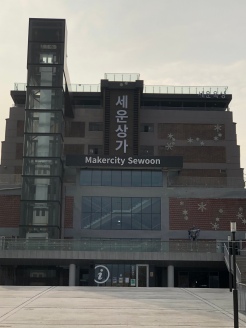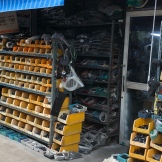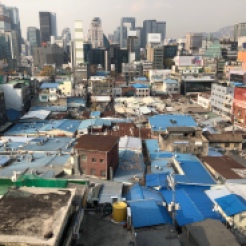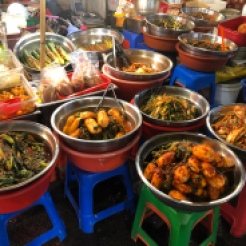Preservation
by afatpurplefig
We met a special human yesterday. And, honestly, if everything turned to utter shit tomorrow (which it won’t, because I actually think I deserve some sort of degree in holiday planning), it would be ok, because I will always be able to think back to Q and the extraordinary day we shared with him, namely his ‘Hidden Look of Seoul with an Artist’.

(Disclaimer: historical facts may not, in fact, be historical…or even facts, since they are based entirely on the foggy memories of a mind filled with wonder.)
We met at Seoul Cinema; three Americans, two Australians, a Thai and Q, who was late. He was very easy to forgive, though (unlike the Pilates instructor), and started things off by telling us a little bit about the history of Korean film. It was interesting to note the combination of Chinese and Korean characters on many of the movie posters, and to hear that some older Koreans still use Chinese characters to spell their names.
We soon headed to an extraordinary building, the exploration of which was to make up a huge part of our tour. ‘Makercity Sewoon’ was the first residential complex in Korea, and the first apartment to house an elevator. According to Q, politicians and movie stars once lived here and to be a resident was to be viewed with great envy.
What you can’t see from this image, or from any that follow, is that the complex goes back a full kilometre from this facade, and is made up of several buildings. Before entering, this robot gives you a brief recap on the history of the building (in Korean), complete with moving arms and sound effects (and ok, it’s early to call, but there is a definite robot pattern forming here…).
It was once said that you could construct a tank or missile from all the parts found inside Sewoon, and that may well be true. It is like a rabbit warren of tiny square rooms, many filled to the brim with…um, stuff…with a distinctly electrical theme.
Special mention goes to this shop, for obvious reasons:

Many of the stores are unattended. Those that are, are mostly overseen by mature men in smart clothing, dwarfed between Rinnai packing boxes and towers of amplifiers and arcade games in pieces. In front of one door was the biggest single speaker I have ever seen, resplendent in 70s wood veneer. Behind another, the owner was carefully cleaning the shelves of an immaculate space whose inventory didn’t appear to include much more than a few packets of ramen. I desperately wanted to photograph them (but more desperately wanted to avoid making anyone feel like an exhibit).
Despite hearing that it is commonly thought of as ugly, parts of the building are hauntingly beautiful.
I mean, seriously, how spectacular is this?

The architect, who died about twenty years ago, was later discovered to have also designed a secret dictator’s prison that was used to torture dissidents in the 70s and 80s, which might be why this series of buildings is a favourite for movie directors, and particularly those that shoot horror.
Sewoon, slated for demolition several times over (but apparently spared due to its proximity to the Jongmyo shrine, a UNESCO world heritage site), is currently undergoing a transformation. City Hall has repaired and renewed parts of the building and now awards spaces to artists, resulting in some of the most incongruent neighbours imaginable. Here is Mary with ‘Touching the Streams’, an artwork whose movement, when being touched, is reflected onto a screen on the floor.
And here is where it lives:

There have also been admirable efforts made to document the history of the building, in strange little rooms that look like this:
Efforts to train the current storekeepers in using the internet for their sales have largely been unsuccessful, but I imagine this space is about community as much as it is business, so I didn’t find it surprising. I guess they will eventually move on and be replaced with something new, which is both sad and hopeful, in a circle-of-life kind of way.
The rooftop space is truly wonderful:

The areas on either side of the building look like this:
Unfortunately, they will not be so lucky. Once a settlement for post-war refugees, and now home to a mass of winding lanes and tiny businesses, these areas have finally succumbed to the pressure of development, and will soon look like this artist’s impression (Sewoon is visible as the rectangular blocks on the right hand side of the main image below):

From Makercity Sewoon, we wound our way through the alleys of Euljiro:
…and found ourselves at one of the most unexpected spaces I have ever seen (see The Great Coffee Tour: 4F). It was here that Q told us a little about his art. A visual and documentary artist, Q has long been interested in lost communities. In Korea, if 70% of the residents of an old area agree to move (the ones who get in quick and are handsomely compensated for doing so), the remaining 30% can then be forced out (and generally receive nothing). For a recent project, he recorded interviews with the residents of a old area that was set for redevelopment then, after it had been cleared, he and his friend (posing as university professors), went in to collect memorabilia from the abandoned homes. He then combined the two as a way to preserve the memories of the area that was lost.
I told you…we met a special human.
We then made our way through the Ban San Market, which specialises in packaging (“Apple! Everything!”), and the Gwang jang Market, characterised by fabrics, and what may be the most incredible range of vintage clothing I have ever seen:
…to the very exciting conclusion to our tour, namely the food section of Gwang jang Market:
Q bought us gimbap (is it unfair to say it’s a bit like sushi?) and pajeon (a giant pancake made from mung beans, and seriously one of the best things I have ever eaten), and explained to us the importance of kimchi, with many families having a special kimchi recipe of their own. Here is a range of different kinds of kimchi, with a huge bowl being made as we were watching:
Then, with a quick selfie and a link to his Instagram account, he was gone, leaving me a little overwhelmed with gratitude. Here is our little crew:

From there, Mary and I wandered off to try and find some lunch. We must have looked aimless, because these two ladies just kind of grabbed us and told us to sit down and eat our bibimbap, with the tolerant yet firm air of parents insisting their children eat their vegetables. They seemed to know what we wanted before we even knew ourselves…and they were probably right. Is a possible to have many things that are the best thing you’ve ever eaten? I say yes!




































We ate gimbap yesterday too. It is like sushi, except more topping to rice, and it contains crisp pickles.
To be fair, I think we should eat sushi in Japan, and say ‘this is very much like gimbap!’… 🙂